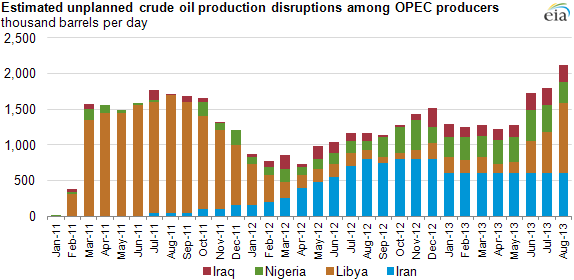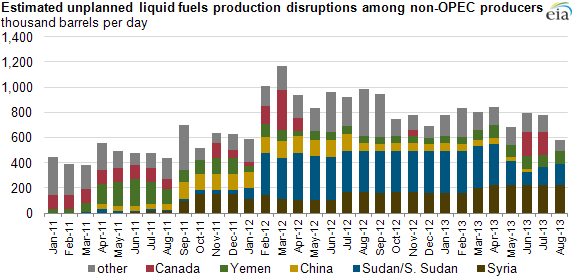
Global crude oil supply disruptions and strong demand support high oil prices

While Brent crude oil spot prices have increased as much as $7 per barrel (6%) since the chemical weapons incident in Syria on August 21, 2013, market fundamentals had been moving Brent prices higher even earlier. From mid-April to August 20, Brent crude oil spot prices increased almost $15 per barrel (15%) because of increasing global refinery demand coupled with record levels of unexpected crude oil production outages, notably in Iraq and Libya. Global unplanned crude oil and liquid fuels disruptions averaged 2.7 million barrels per day (bbl/d) in August, the highest level over the period January 2011 through August 2013.
Oil supply disruptions in key producing countries are up sharply:
- Libya. Protests at many seaport facilities have blocked exports, and, as a result, crude oil supply disruptions averaged close to 1 million bbl/d in August, up from 0.13 million bbl/d in April. Pipeline closures by militia groups at the end of August have worsened the situation, with disruptions rising to 1.35-1.4 million bbl/d by the end of August.
- Nigeria. Disruptions in June on key pipelines helped curtail almost 450,000 bbl/d of production, up 100,000 bbl/d compared to May. Production recovered somewhat by August when 290,000 bbl/d were off-line.
- Iraq. Persistent attacks on the pipeline from Kirkuk to Ceyhan in Turkey helped push disruptions of Iraqi crude oil production to 250,000 bbl/d in August, up 100,000 bbl/d from April. In addition, September maintenance at the Iraqi port of Basra could further reduce exports by several hundred thousand barrels per day. Although the Iraqi government has stated that exports will not be affected, a preliminary September loading schedule indicates a decline of several hundred thousand barrels per day.


Syria is not a major crude oil producer, and significant volumes of crude oil do not move through the country to reach global markets. Before the civil war began in 2011, Syria produced around 400,000 bbl/d of crude oil and exported about 150,000 bbl/d, mostly to Europe. However, ongoing hostilities, which have significantly affected energy infrastructure, combined with stringent international sanctions on petroleum exports from Syria, cut crude oil production by about 85%. As a result, while the recent events in Syria have pushed Brent prices higher on concerns about wider geopolitical unrest in the Middle East, they have not reduced the physical flow of crude oil into the global market.
Concerns about geopolitical unrest will likely continue to affect crude oil prices. However, other factors could push crude oil prices lower:
- Seasonal demand patterns. Seasonally, global crude oil demand declines in September—the International Energy Agency (IEA) expects global crude runs to fall 2.1 million bbl/d in September from their July peak to 76.2 million bbl/d, and to fall an additional 0.3 million bbl/d in October.
- Rising non-OPEC production. EIA projects non-OPEC liquid fuels production to increase almost 2 million bbl/d in 2013, with fourth-quarter 2013 production 0.7 million bbl/d above the third-quarter level, helping to offset production disruptions elsewhere. Crude oil production in the United States is forecast to account for about 40% of this growth.
- Sustained Saudi output. EIA expects Saudi Arabia to maintain elevated crude oil production of almost 10 million bbl/d into the autumn if high volumes of global production remain disrupted. Seasonally, Saudi Arabian production typically declines at the end of summer, falling in line with its declining domestic consumption, which peaks in the summer. Sustained production provides greater volumes for export, partially offsetting disruptions elsewhere.
For more information see EIA's September Short-Term Energy Outlook and special supplement on supply disruptions, as well as EIA's Country Analysis Briefs on Libya, Iraq, Nigeria, and Syria.
Tags: disruption, international, Iraq, Libya, liquid fuels, Nigeria, oil/petroleum, prices, Saudi Arabia, Syria